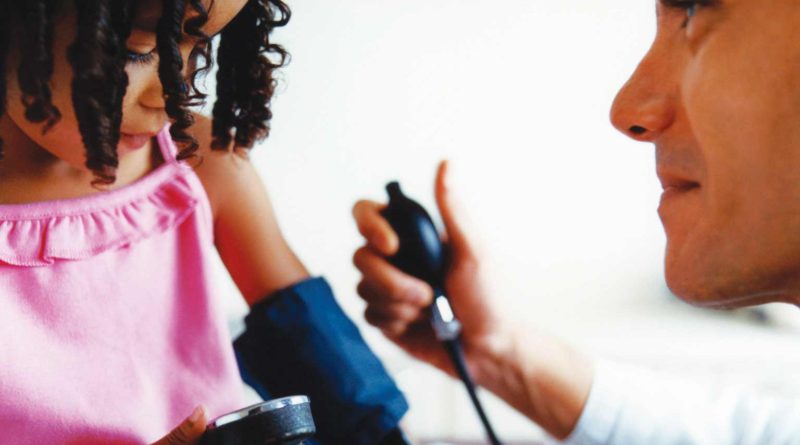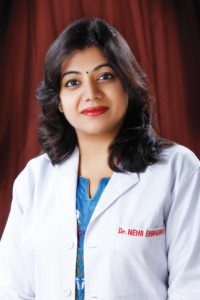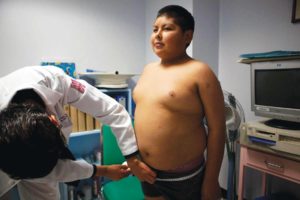“Parents should take steps to avoid hypertension in children”
Contrary to popular belief, high blood pressure (hypertension) can occur, even in newborns and young children. The problem may go undetected, because many a time there are no symptoms or signs of this disease. If left untreated hypertension can lead to heart failure, vision problems, kidney failure, paralysis and stroke early in life. In an exclusive interview with Double Helical, Dr Neha Bhandari, Paediatric Nephrologist, Sri Balaji Action Medical Institute, New Delhi throws light on hypertension in children and the need for treatment at the right time to avoid the dreaded complications.
Excerpts from interview…
1. Can high blood pressure occur in children?
It is a general belief that high blood pressure (hypertension) as a problem affects only adults. Contrary to this belief, hypertension can be present at any age, even in newborns and young children. When the parents learn that their child has hypertension, it is very natural for them to deny the possibility due to their ignorance. It is for the paediatrician and the paediatric nephrologist to clear their doubts and initiate appropriate management plan.
2. What is high blood pressure (BP)?
Blood pressure is the force of the blood against the walls of blood vessels as the heart pumps bloods to various parts of the body. If this pressure becomes too high, the child is said to have high blood pressure or hypertension.
3. What do numbers in a BP reading mean?
As in adults, a child’s BP is read as two numbers. The first number or systolic BP is the pressure when the heart is pumping blood to various parts of the body. The second number or the diastolic BP is when the heart is resting between the beats. The diastolic BP is less than the systolic BP. A child is considered to be hypertensive when either the systolic, diastolic or both blood pressures are high.
4. How common is the problem?
You will be surprised to know that approximately 2-5% of children suffer from hypertension, with the majority unaware that they have this problem. A rise in incidence of hypertension has been linked to concurrent increase in prevalence of obesity. The prevalence of hypertension in obese children is higher and ranges from 10-30%.
5. What happens if hypertension is not detected or not treated properly?
If hypertension is allowed to continue or become worse over years, the prolonged extra pressure in the blood vessels can lead to heart failure, stroke, damage to eyes and kidney even in children.
6. When is BP too high in a child?
Normal BP is lower in children than in adults. BP increases with age and body size. Normal BP for a child will depend on the child’s age, sex and height. The doctor compares your child’s BP to readings given on BP charts which lists normal BP or high BP for boys and girls based on their height and age. A child is said to be hypertensive if his average systolic or diastolic BP is more than 95th percentile (according to the standardized charts) for age, gender and height on more than 3 occasions. BP charts are provided at end of this article for ready reference. Your doctor is the best person to read and interpret the charts.
7. Are there any values of BP which can guide parents to consult the doctor?
To label a child as hypertensive, BP charts have been issued by the fourth US task force report on hypertension.These are charts consulted by doctors to arrive at a conclusion whether the child has hypertension or not. Since these charts are difficult to interpret and not easily available to parents, it is recommended that if your child’s BP is beyond the values listed in the table below for the specific age group, you need to consult your doctor (paediatrician/paediatric nephrologist)
8. Is there any grading of hypertension?
Yes, hypertension has been graded according to the B.P readings
a) Prehypertension: – Blood pressure is > 90th percentile but <95th percentile (as per BP chart). Children in this range of BP should be carefully followed up as they grow up.
b) Stage 1 hypertension (Unsafe):- BP exceeds 95th percentile up to 5 mm above 99th percentile. Blood pressure in this range should be rechecked at least twice in the next 1-3 week or even earlier.
c) Stage 2 hypertension (Dangerous):- BP exceeds 5 mm or more above the 99th percentile. Confirmation should be made at the same visit.
9. Should all children get their blood pressure checked?
Children who are more than 3 years and are seen at health care setting (for example cold, cough or fever) should have their blood pressure measured. Children who are less than 3 years should get their BP cheeked if they have:
a) History of low birth weight, prematurity or requirement of neonatal intensive care.
b) History of heart disease by birth
c) History of recurrent urinary tract infection
d) History of blood or protein loss in urine
e) History of any kidney disease in the past
f) Family history of kidney disease
g) History of organ transplantation
h) History of receiving medicines which can cause high blood pressure/kidney damage
10. What are the symptoms of hypertension?
The usual symptoms of hypertension are headache (sometimes throbbing in nature), flushing, giddiness, bleeding from nose, vision disturbances, poor school performance, irritability, blood or protein in urine, passing urine more or less frequently and weight loss. In some cases hypertension can be without symptoms. Therefore those children, who are obese, have history of neonatal intensive care stay, or have kidney/ heart disease or cardiac disease should have their blood pressure checked.
11. How is blood pressure checked in a child?
Generally it is preferred to check the blood pressure when the child is sitting comfortably in a chair with feet on the ground and the arm at the level of the heart. The BP cuff should be of the right size for the child’s age.
The width of the cuff bladder (rubber inside the outer cloth) should be 40% of the arm circumference midway between the shoulder and elbow joint and the length should be double the width. Another simple way is to get a bladder cuff whose width covers ¾ of the upper arm. If the cuff size is not appropriate the blood pressure readings may come falsely high or low. However, if an appropriate cuff size is not available the next bigger size can be used. Cuff sizes with a width of 4 cm, 9cm, 10cm, 13cm, and 20cm are available in the market.
12. Which instrument is best for checking blood pressure?
Mercury instruments are the best for checking blood pressure, but as they are being phased out, aneroid devices are being used more commonly and they are fairly accurate, but they require frequent calibration.
Automatic BP machines are also being used .If an automatic (digital) blood pressure machine is being used and blood pressure readings come high, then they need to be confirmed with mercury or aneroid device.
13. What is Ambulatory Blood Pressure Monitoring (ABPM)?
ABPM means blood pressure is recorded over a 24 hours period by a BP monitor where cuff is tied to the arm and a small digital blood pressure machine is attached to a belt around the waist. The child carries on his/her normal activities in the day and sleep with it, while the machine is on. The machine takes the blood pressure readings at regular intervals usually every 15-30 minutes during the day and night. The monitor should be kept on throughout the night. At the end of 24 hours the cuff and the machine are removed and given to the hospital for analysis of readings. For the machine to work properly, it is important to make sure that the tube attached to the machine is not twisted or bent. As a parent you are instructed to maintain a diary, to note timing of going to bed, medication and general activities.
There are a number of reasons why a doctor advises 24 hour ABPM, which are:
a) To find out if the high BP reading in the clinic is higher than the reading away from clinic e.g. home (called white coat hypertension).
b) To see how well the medicines are working and whether they are controlling the blood pressure all the time.
c) To see whether blood pressure at night is less than the recording during the day time.
14. What are the causes of hypertension in children?
In majority of young children an underlying cause of hypertension can be identified e.g. kidney, heart, blood vessels, hormone problems, tumour or drugs. Diseases of the kidney are the most common cause of hypertension in children. Primary or essential hypertension, commonly seen in adults, is becoming common in children, who are obese or over weight.
15. If a child is noted to have high blood pressure, will he/she always remain hypertensive?
If a cause for hypertension is diagnosed, appropriate treatment can be initiated and the child may have normal blood pressure afterwards. For few reasons, a child may have to remain on anti-hypertensive medicines throughout the life.
16. Are there any investigations which are required to be done in a child who has hypertension?
Once a child is diagnosed to have hypertension, it is very important to evaluate for any underlying disease and to find out risk factors for essential hypertension like obesity, smoking, alcohol, etc. In addition tests are required to find out if any complication (involvement of eye, heart or kidney) has occurred or not. The common tests which may be required are: kidney function tests, hormone levels, lipid profile, urine examination, ultrasound and doppler test of kidney, kidney scan, echocardiogram, ECG and eye examination.
17. How is hypertension treated?
Most children with essential hypertension require lifestyle modifications which include weight reduction, meditation, yoga, exercise, low salt diet (<3.5 gm/day).Other risk factors like smoking, alcohol, steroids, oral contraceptives, sleep apnea should also be controlled. For secondary hypertension, surgery helps in certain cases, e.g. if any tumour is causing hypertension, then it needs to be removed surgically.
18. What are the indications for drug treatment in hypertension?
a) Stage 1 hypertension persisting even 6 months after lifestyle modifications or those who have any pre-existing kidney disease
b) Stage 2 hypertension
c) Damage to eye, kidney, heart, or brain has occurred
d) Pre hypertension in a child with chronic kidney disease, diabetes or lipid abnormalities
19. What are the advantages of early detection of high blood pressure?
Timely detection helps in appropriate treatment of hypertension and its cause and helps to prevent organ damage in adult life.



